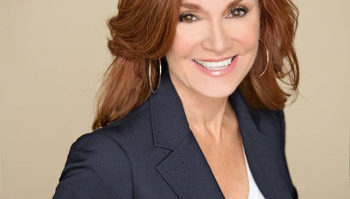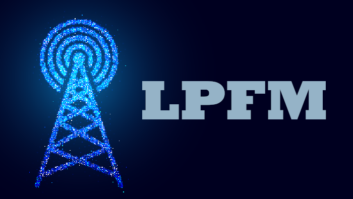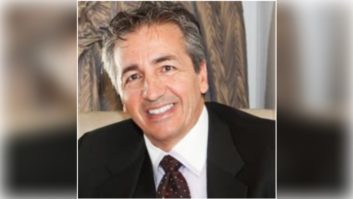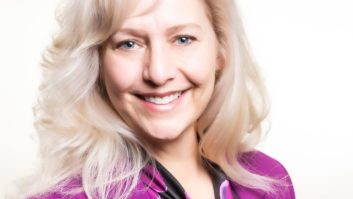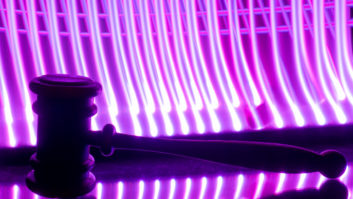Americom Reno
Aug 1, 2007 12:00 PM, By Bill Schulz
The tower behind the Americom Reno facility, erected by PNR systems, includes nine Comsat STL microwave dishes that beam to nine transmitters between five transmission facilities. A lack of T1 lines to the transmission sites along with rugged terrain made microwave STL a must.
The KODS-FM studio is centered around a Harris Netwave console and Prophet Nexgen automation. Rack equipment at KODS includes Denon CD players and a Gentner Digital Hybrid II phone system. A Harris World Feed panel for plug-in systems is integrated into the top of this rack.
A rack row in the technical operation center houses the on-air processors, RF monitoring equipment and EAS encoders/decoders.
Traffic reporter and on-air talent, Trey Valentine at work in Production 2.
Bill Schulz hosts the morning show from the KCLA-FM air studio.
Talk show host Panama hosts The Panama Show from 9 a.m. to noon Monday-Friday from the KBZZ-AM talk studio. The custom talk table features countertop-mounted delay systems.
The set-up in Production 1 shows the typical console and automation system layout in each studio.








The front entrance to Americom Reno. The first floor houses the administrative and sales operations; programming operations and technical engineering is centralized on the top floor.
The roadmap to HD Radio broadcasting can be planned in from various starting points. While some operations have the luxury of initiating an all-at-once upgrade, most are forced to start either at the studio or the transmission site.
In the case of Americom Reno, a seven-station, medium-market radio operation in the heart of Nevada, our path to HD Radio starts at the studio. Our recent move to a new facility is not the classic example of consolidation, bringing multiple stations in different facilities under one roof. All seven stations (KRNO-FM, KODS-FM, KLCA-FM, KCTQ-FM, KBZZ-AM and KJFK-AM; and Scott Communications-owned KWNV-FM, for which Americom Reno provides programming, operations and engineering sources) were centralized in our previous facility as well. Instead, the move tells the story of a growing station group requiring more on-air and production flexibility as it lays the groundwork for HD Radio.
The opportunity to move came with somewhat of a push when our previous facility, a high-rise rental in downtown Reno, was sold. The move was welcomed, as it allowed us to upgrade our technical platforms and IT department in a larger facility instead of forcing everything into the dwindling space of the high-rise. Our parent company purchased a business plaza and had the existing area in the center of the building completely restructured and reformatted. (Tenants were retained on the outer edges of the two story plaza).
The facility layout is simple, with administrative offices, sales team, and the traffic and billing department located downstairs, along with various conference rooms, a telephone bank and a gigantic sales pit for large business meetings. The second floor is dedicated to programming, with seven control rooms, two production studios, one talk studio and a technical operations center (TOC).
The move was completed over the course of several weeks, with Harris leading the technical relocation project. The stations went on the air in a staggered launch, as a new tower was erected behind the facility to accommodate transmissions � currently all analog. This included multiple microwave dishes for STL with an array of antenna systems.
Harris was selected to lead the project because of a long relationship that included our previous relocation project. Harris provided all the integration work in both facilities: As the only radio outlet for our company, we have only one contract engineer and a handful of volunteers. A group of Harris engineers led by Hal Welch came in beforehand to perform a full job analysis, and Welch’s familiarity with our previous system made the move and integration process that much smoother.
All seven on-air studios feature Harris Netwave-12 digital on-air consoles, with Vistamax Envoy networking for audio/program routing and source sharing. A Harris rep analyzed our routing needs, pertaining especially to our satellite programming and two AM stations for live talk routing, and determined the Envoy was the appropriate platform for this facility. All on-air and production studios have Envoy frames tied to the main Envoy system in the TOC.
The Harris Netwave consoles (16 channels, 12 faders) work the same way as the larger RMX Digital console but offer a more attractive price point. Sources are added to the console simply by sliding off the back panel and punching in the source. Typical sources for the on-air Netwaves include mics, four Prophet Nextgen automation buses, two Tascam CD players, Telos or Gentner phone systems, and two routing buses from production.
The last two faders on the Netwave boards are dial-ups for Envoy, allowing the studio to dial up any source in the building. We can block certain programming to specific consoles using Envoy. This means that if only one station will ever air a specific program received via satellite, it won’t appear on the Envoy dial-up function in other studios. We typically include 15 potential sources per fader. This cuts down on time spent flipping through channels on the Envoy to call up the appropriate source.
All studios have a World Feed Panel, a utility panel designed by Harris encased in a wood frame. TV crews and live bands can plug directly into this panel, which can also be used for temporary audio sources such as Ipods or laptops. The World Feed Panels provide a variety of input jacks (RCA, XLR, �”, ?”).
Operators can manipulate the audio from these World Feed Panels through a direct CAT5E wiring connection to a Netwave console. The panels connect back to TOC over the same CAT5E wiring, and can therefore be used in any room that runs cabling to and from TOC. The panels are very portable, so a large band or syndicated show that cannot fit into a studio can create a show from the first-floor conference room. The World Feed Panel plugs into the floor and sends the audio back to TOC and into the main Envoy frame, where it is then routed onto the appropriate studio destination.
Routing and control
The Prophet Nextgen system provides automation services for all studios. The complete system for each studio comprises one main and three auxiliary pods. A Broadcast Tools four-input switcher connects to the Prophet computer so the operator can bring the system up through Envoy if the control board goes down. Envoy also provides redundancy for the consoles during Netwave maintenance, and the Prophet system is flexible enough that we can automate all seven stations from my desk if any unusual maintenance issues arise.
The Broadcast Tools switcher can also be utilized to override on-air programming. In case of an emergency, we can air a live news feed to any station.
Our mass production room measures 16.5′ � 9.5′, and the secondary room measures 9.5′ � 8′. Both use Netwave eight-channel consoles. At first glance these might seem far less powerful than the 32-fader Mackies we used for production in our previous facility. Since most of our production is mixed in the IT department these days, we decided to install smaller consoles in our new production studios to provide plenty of production capability but also provide space for other systems.
Each production room uses a Shure SCM268 mixer to control multiple Sennheiser MD-421 and Audio Technica microphones. Two Prophet buses are utilized on the board as opposed to the four used in the on-air boards. Two routing buses for Envoy, a Numark CD player, and ProTools editing system round out the sources. Material can go directly to air via Envoy; otherwise it is ingested into Prophet or burned to CD for later use.
We decided not to connect our Prophet system to the Internet because of virus threats, although we can connect manually when required. MP3 files from production sessions are dumped into Adobe Audition audio editing computers prior to being sent to air, ingested into Prophet or burned to CD. Each production studio is also outfitted with a Protools system for production flexibility, but the Audition systems are our primary editing systems.
Solid foundation
Each on-air and production studio features Harris Quickline II furniture. The main furniture piece adds a double guest wing in the production rooms and several FM studios to provide plenty of room for guests to stretch their legs.
The Netwave console and Prophet systems sit atop the main furniture surface, along with various on-air and production components. The KLCA studio, for example, uses a 360 Systems Shortcut for live effects. The Shortcut is wired directly to the Envoy frame in the studio. A 360 Systems Instant Replay has also recently been added to this studio. Most on-air studios also feature Airnet machines and Adobe Audition digital editors on the Quickline surface for production assistance, meaning each on-air studio can also act as a production room when necessary.
Each Quickline II piece features a turret for cable runs and built-in mountings for XLR jacks and mic booms. Built-in headphone jacks are installed in both host and guest positions. These are very solid phone jacks dropped into the surface with a rugged design that won’t break down within six months. Our older furniture used quick-solder jacks for headphones that broke down often, so this was a positive change for show hosts and the engineering staff.
The 12.5′ � 16′ talk studio features a Harris Smoothline talk table with a long countertop. A full-blown cabinet at the end of the talk table features an Airnet machine, with a conduit leading to the Telos telephone system on the countertop. The cabinet also features Shure SCM268 microphone mixers, rackmountable Symetrix501 on-air processors, and AirTools 6000 broadcast on-air delay systems � all locked behind a door, out of sight and out of mind.
The cables are run through turrets to connect to the components used for our live talk programs (two per day, one for each AM). Harris also added Pro Booms (i.e., fancy mic booms) with a sleek appearance, and added a sunken interface for the delay system, complete with a dump button. A Henry Engineering Superely was also added to toggle back and forth between our two AMs for monitoring.
The Smoothline piece features three separate positions at the talk table with room for five. There are two host positions on each side of the table: One side looks into the KBZZ studio, while the other side looks into KJFK. The guest position at the end of the table looks down the length of the table, and the table adds an Envoy frame for audio routing if necessary.
The Envoy system also allowed us to better organize the TOC. Many engineering rooms have walls and walls of punchblocks. Our back wall is very clean with much less wiring. The Envoy design utilized a basic punchblock system � very user-friendly for engineers and easy to swap connections when necessary. The CAT5E trunk cables were custom-made by Harris at its Quincy facility. Welch and his crew pulled all the wires from the individual rooms using a wire tray and ran them neatly and professionally into the TOC.
Behind the scenes
Eight custom Harris equipment racks house the TOC equipment. One rack is completely dedicated to Envoy, with a second rack devoted to our Prophet Systems utility machine and the Prophet Nextgen dual servers and DRR. The Envoy acts as a traffic cop, receiving all the signals in the facility and routing them to the appropriate device. It includes a list of commands that tells the system where to route specific signals. That list is controlled through the utility machine, which talks to Envoy, Prophet and the Netwave consoles.
All major external programming enters our facility through Starguide satellite receivers. Five Starguide devices in the TOC receive and decode the signals, mostly from Westwood One, Jones Radio Network and CBS feeds. Most of these signals are then transported over CAT5E wiring to Envoy. Raw signals can go straight to air; signals with coding issues are routed to Prophet.
Optimod on-air processors (8100 to 8500) with spatial enhancers and an XT chassis are installed across racks 3 through 8, along with the five Starguide satellite receivers. The Optimods are the last devices in the signal chain.
An HVAC system on the roof feeds a unit positioned in the center of the TOC ceiling, providing an open air dump into the room with plenty of cool air to the keep the equipment in top operating form. A Staco STCSC3001 UPS system provides the power supply for all the TOC equipment, and the Harris equipment and Prophet system came with dedicated UPS systems. Our staff installed a CAT generator outside, which sits on a concrete slab and provides plenty of juice to the facility in the event of a power outage.
The location of this building offers a direct line of sight to our tower and antennas. The tower, erected by PNR Systems, adjoins directly to the rear of our facility and includes nine microwave STL dishes: one for each station plus two backup dishes. The Comsat 6′ STL grid dishes were provided through Harris with tower coaxial cabling from Andrew. Microwave STL connections were necessary due to terrain issues and lack of telephone lines to most of our transmitter sites.
The dishes connect directly to the TOC, with a quarter-inch coaxial cable to the room, and a 1-1/4 coax run down the side of the building, approximately 350 feet from the tower. A trench was dug in the parking lot for a conduit to run cable from the side of the building to the tower. The nine dishes beam to nine different transmitters at five sites. Our largest transmitter site, with KDOS, SLCA and KRNPO, are located on Slide Mountain.
Our STL system is designed with an HD Radio broadcasting future in mind, with plenty of capacity and power coming off the dishes to handle HD Radio signals. first step of this process was to fix everything at home first, moving everything to non-compressed audio that is of better audio quality and is 100 percent compliant with HD Radio. We could immediately tell the difference in audio quality when we switched from our previous automation system to the new one.
Our automation system will also allow us to initiate datacasting in the near future, with Envoy taking a direct data feed from Prophet and pushing those text-based streams to air. With our studio systems in place, we appear to be in excellent shape for an HD Radio future, and seemingly ahead of many of our broadcasting peers in the Reno market.
Schulz is director of programming and operations, Americom Reno.
Equipment list
360 Systems Short/Cut
50-Pair Krone blocks
Adobe Audition
Audio-Technica mics
Broadcast Tools four-input switchers
Comsat STL antennas
Denon CD players
Digidesign Pro Tools
Electro-Voice RE-27 ND
Gentner Digital Hybrid II
Harris 3�6 headphone amps, Integrator racks, Netwave, Quickline II, Smoothline, Vistamax Envoy
Henry Engineering Superelay
JBL Control 1
Mackie HR626 powered reference monitors
Middle Atlantic 500 Rack Screws
Numark CD players
O.C. White mic booms
Orban Optimod 8100 and 8500 audio processors
Panduit Minicom patchbays
PNR Systems tower
Prophet Nexgen
Radio Systems BOB1024
Sennheiser MD421
Shure SCM268, Popper Stopper
Staco STCSC3001 UPS
Starguide satellite receivers
Symetrix Air Tools 6000, 501E
Tascam TEACD01UPRO CD Players
Telos 1�6





